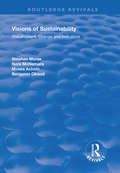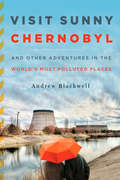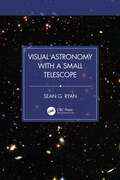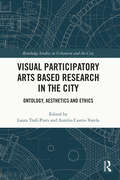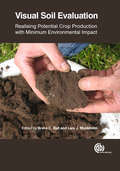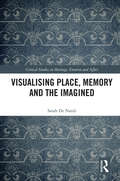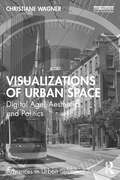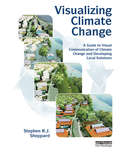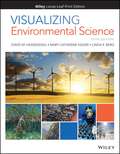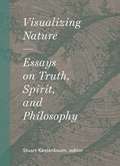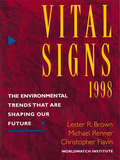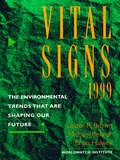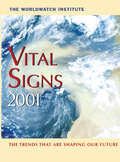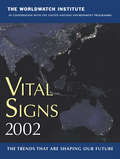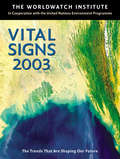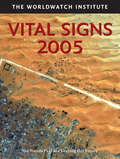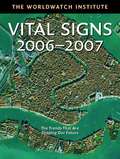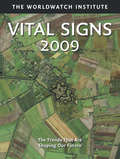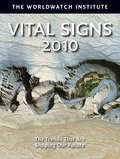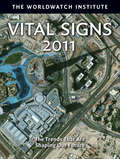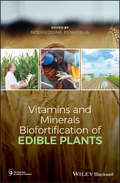- Table View
- List View
Visions of Sustainability: Stakeholders, Change and Indicators (Routledge Revivals)
by Stephen Morse Nora McNamara Benjamin OkwoliThis title was first published in 2000: Sustainable development has grown to compass cultural, socio-economic, political and environmental issues, and the use of Sustainability indicators (SIs) is seen by many as central to its implementation. After all, how can one ’do’ sustainable development unless one knows when it has been attained? The adoption of SIs in such a context is logical, but does present a number of practical difficulties. So far much of the published material consists of theoretical SI frameworks, with little practical experience on their use in development scenarios. In contrast, this volume is based on the results of a six year project designed to develop and evaluate the use of SLs in a Nigerian village. For the first time this takes into consideration the views and perspectives of the local population, and in doing so addresses key issues that are vital for anyone attempting to put sustainable development into practice.
Visit Sunny Chernobyl: And Other Adventures in the World's Most Polluted Places
by Andew BlackwellFor most of us, traveling means visiting the most beautiful places on Earth—Paris, the Taj Mahal, the Grand Canyon. It's rare to book a plane ticket to visit the lifeless moonscape of Canada's oil sand strip mines, or to seek out the Chinese city of Linfen, legendary as the most polluted in the world. But in Visit Sunny Chernobyl, Andrew Blackwell embraces a different kind of travel, taking a jaunt through the most gruesomely polluted places on Earth. From the hidden bars and convenience stores of a radioactive wilderness to the sacred but reeking waters of India, Visit Sunny Chernobyl fuses immersive first-person reporting with satire and analysis, making the case that it's time to start appreciating our planet as it is—not as we wish it would be. Irreverent and reflective, the book is a love letter to our biosphere's most tainted, most degraded ecosystems, and a measured consideration of what they mean for us. Equal parts travelogue, expose, environmental memoir, and faux guidebook, Blackwell careens through a rogue's gallery of environmental disaster areas in search of the worst the world has to offer—and approaches a deeper understanding of what's really happening to our planet in the process.
Visiting the Past: A Guide to Britain's Archaeology
by Gillian HovellArchaeology isn’t just for academics and television presenters – it’s for everyone. And it is all around us. Get your boots on and explore Britain’s national and local archaeology sites for yourself with this revised and updated, easy-to-read, fully illustrated guide.Follow our islands’ history in this step-by-step introduction. Discover what life was like from the earliest days of human habitation right through to the world wars. Then get out to visit the best sites and see what features each era left behind for us to find – and find out how to spot archaeology for yourself in the most surprising places.Be warned: you may never look at an empty field, a stone monument or an old building in the same way again!
Visual Astronomy with a Small Telescope
by Sean G. RyanThis is a practical guide to using a small astronomical telescope of a size that corresponds to most “first” telescopes – around 75-150 mm, i.e. 3-6 inches, in diameter.Visual Astronomy with a Small Telescope is for people who are sufficiently interested in astronomy to have purchased a small telescope or received one as a gift, but who are still developing experience of using one. They may have looked at the Moon and major planets and be wondering, “What's next?” There are many books catering for casual star-gazing and many more advanced books dealing with astrophotography and astrophysics, but this is for someone who has acquired their first telescope or soon will and wants to make the most of it.It explains how the optics of the telescope function, so the reader understands what their telescope can do and how eyepieces should be selected and used depending on the type of object being observed. It details different types of astronomical objects, their astrophysical significance, and how to observe them. It contains 43 detailed, clear charts and describes 380 objects suitable for visual observation with a small telescope and explains how to locate them without needing a computer-controlled telescope. It will help readers make the most of their telescopes to successfully observe the Universe and kick-start a life-long interest in star-gazing.• Presents essential information on optics, astronomy and astrophysics for anyone with a small telescope. • Contains 43 detailed charts, based on the constellations and showing stars down to magnitude 8.5, and identifies 380 objects suitable for visual observation with a small telescope. • Written by a Professor of Astrophysics with experience as both an amateur astronomer and a professional observational astronomer using telescopes at both small and major observatories around the world.
Visual Participatory Arts Based Research in the City: Ontology, Aesthetics and Ethics (Routledge Studies in Urbanism and the City)
by Laura Trafí-Prats Aurelio Castro-VarelaVisual Participatory Arts Based Research in the Cities maps ontological, aesthetic and ethic differences between humanist and posthumanist arts-based research, while providing insight on methodological orientations to develop arts-based research with frameworks based on process-philosophies. It is the first book on arts-based research which focuses on the city, adopting a posthumanist approach to the assembled nature of urban environments, where agency is distributed across infrastructures, technologies, spaces, things, and bodies. Chapters one to seven feature a series of studies, situated in different cities in Europe and the Americas, which outline experiences of movement, inhabitancy, interdependence, collaboration, infrastructuring and sensorial re-calibration informed by art practices in film, photography, digital projection, installation, performance and art as social practice. At the core of this book is the idea that aesthetic ecologies of cities do not depend solely on human activity, relying instead on non-logocentric modalities of collective life. The book is an indispensable tool to researchers, instructors and graduate students in education, the social sciences and the arts aiming to conceive, design and develop projects in arts-based research.
Visual Soil Evaluation
by Bruce C. Ball Rachel Guimarães Tom Batey Anne Weill Dick Godwin Lothar Mueller Mary Norton Scherbatskoy Joanna Cloy Lars J. MunkholmVisual Soil Evaluation (VSE) provides land users and environmental authorities with the tools to assess soil quality for crop performance. This book describes the assessment of the various structural conditions of soil, especially after quality degradation such as compaction, erosion or organic matter loss. Covering a broad range of land types from abandoned peats to prime arable land, this useful handbook assesses yield potential across a range of scales. It also appraises the use of VSE in determining the potential of different land types for carbon storage, greenhouse gas emissions and nutrient leaching, and for diagnosing and rectifying erosion and compaction in soils.
Visual Soil Evaluation: Realizing Potential Crop Production with Minimum Environmental Impact
by Rachel Guimarães Tom Batey Anne Weill Dick Godwin Lothar Mueller Mary Norton Scherbatskoy Joanna CloyVisual Soil Evaluation provides land users and environmental authorities with the tools to assess soil quality for crop performance. An important tool for ensuring food security, this book appraises the use of visual soil evaluation in determining the potential of different land types for carbon storage, greenhouse gas emissions and nutrient leaching. Providing a guide to diagnosing and rectifying soil problems, it includes: - Full colour illustrations throughout to show variation of soil quality and aid evaluation - A broad range of land types, from abandoned peats to prime arable land - Assessment of soil structure after quality degradation such as compaction, erosion or organic matter loss Essential reading for students, researchers and scientists interested in soil science and crop production, this book is also a valuable tool for policy makers and environmental authorities. A useful handbook assessing yield potential across a range of scales, it places visual soil evaluation in the context of the future sustainable intensification of agriculture.
Visualising Place, Memory and the Imagined (Critical Studies in Heritage, Emotion and Affect)
by Sarah De NardiThis book probes into how communities and social groups construct their understanding of the world through real and imagined experiences of place. The book seeks to connect the dots of the factual and the imaginary that form affective networks of identities, which help shape local memory and sense of self and community, as well as a sense of the past. It exploits the concept of make-believe spaces – in the environment, storytelling and mnemonic narratives – as a social framework that aligns and informs the everyday memory worlds of communities. Drawing upon fieldwork in cultural heritage, community archaeology, social history and conflict history and anthropology, this text offers a methodological framework within which social groups may position and enact the multiple senses of place and senses of the past inhabited and performed in different cultural contexts. This book serves to illustrate a useful visualisation methodology which can be used in participatory fieldwork and thus will be of interest to heritage specialists, ethnographers and cultural geographers and oral history practitioners who will particularly find the methodology cheap, easy to replicate and enjoyable for community-based projects.
Visualizations of Urban Space: Digital Age, Aesthetics, and Politics (Advances in Urban Sustainability)
by Christiane WagnerThis book explores environments where art, imagination, and creative practice meet urban spaces at the point where they connect to the digital world. It investigates relationships between urban visualizations, aesthetics, and politics in the context of new technologies, and social and urban challenges toward the Sustainable Development Goals. Responding to questions stemming from critical theory, the book focuses on an interdisciplinary actualization of technological developments and social challenges. It demonstrates how art, architecture, and design can transform culture, society, and nature through artistic and cultural achievements, integration, and new developments. The book begins with the theoretical framework of social aesthetics theories before discussing global contemporary visual culture and technological evolution. Across the 12 chapters, it looks at how architecture and design play significant roles in causing and solving complex environmental transformations in the digital turn. By fostering transdisciplinary encounters between architecture, design, visual arts, and cinematography, this book presents different theoretical approaches to how the arts’ interplay with the environment responds to the logic of the constructions of reality. This book will appeal to scholars, researchers, and upper-level students in aesthetics, philosophy, visual cultural studies, communication studies, and media studies with a particular interest in sociopolitical and environmental discussions.
Visualizing Climate Change: A Guide to Visual Communication of Climate Change and Developing Local Solutions
by Stephen R.J. SheppardCarbon dioxide and global climate change are largely invisible, and the prevailing imagery of climate change is often remote (such as ice floes melting) or abstract and scientific (charts and global temperature maps). Using dramatic visual imagery such as 3D and 4D visualizations of future landscapes, community mapping, and iconic photographs, this book demonstrates new ways to make carbon and climate change visible where we care the most, in our own backyards and local communities. Extensive color imagery explains how climate change works where we live, and reveals how we often conceal, misinterpret, or overlook the evidence of climate change impacts and our carbon usage that causes them. This guide to using visual media in communicating climate change vividly brings to life both the science and the practical solutions for climate change, such as local renewable energy and flood protection. It introduces powerful new visual tools (from outdoor signs to video-games) for communities, action groups, planners, and other experts to use in engaging the public, building awareness and accelerating action on the world’s greatest crisis.
Visualizing Environmental Science
by Linda R. Berg David M. Hassenzahl Mary Catherine HagerThe 5th Edition of Visualizing Environmental Science provides students with a valuable opportunity to identify and connect the central issues of environmental science through a visual approach. Beautifully illustrated, this fifth edition shows students what the discipline is all about--its main concepts and applications--while also instilling an appreciation and excitement about the richness of the subject. This edition is thoroughly refined and expanded; the visuals utilize insights from research on student learning and feedback from users.
Visualizing Nature: Essays on Truth, Spririt, and Philosophy
by Stuart KestenbaumVisualizing Nature brings together contemporary visionaries to share deeply personal essays on nature, ecology, sustainability, climate change, philosophy, and more. Compiled by editor and poet Stuart Kestenbaum, the contributors represent a wide range of backgrounds and experiences, each honoring nature's power to heal, inspire, guide, amaze, and strengthen.Activist Maulian Dana of the Penobscot Nation writes on the intertwining relationship of motherhood and Mother Earth. Biology professor David Haskell tells the story of the resilient bristlecone pine trees, which live to be as old as 2,100 years. Iranian scholar Alireza Taghdarreh speaks to his experience of translating Emerson's "Nature" into Farsi. A previously unpublished 1962 speech by Rachel Carson complements the collection of more than twenty essays, each inviting the reader into a quiet space of reflection with the opportunity to think deeply about how they relate to the natural world.
Vital Signs 1998 (Vital Signs)
by The Worldwatch InstituteThe new Vital Signs 1998 gives you more than 100 charts, graphs and tables that show you the worldwide trends that are changing our lives, for better and for worse. It includes the latest data on critical global trends, presented in simple but compelling graphics, along with concise, thoughtful analysis.
Vital Signs 1999 (Vital Signs)
by The Worldwatch InstituteThe global trends documented in Vital Signs 1999--from a decline in nuclear power generating capacity to the proliferation of genetically modified crops--will play a large part in determining the quality of our lives and our children's lives in the next decade.
Vital Signs 2000
by The Worldwatch InstituteThe global trends documented in Vital Signs 2000--from the rapid rise in the sales of energy-efficient compact fluorescent lamps to the worldwide overpumping of growndwater--will play a large role in determining the quality of our lives and our children's lives in the next decade.
Vital Signs 2001: The Environmental Trends That Are Shaping Our Future (Vital Signs)
by The Worldwatch InstituteThe global trends documented in Vital Signs 2001 - from the rapid increase in the use of wind power to the continued warming of the planet - will play a large role in determining the quality of our lives and our children's lives in this new century.
Vital Signs 2002 (Vital Signs)
by The Worldwatch InstituteThe 2002 edition features more than 50 key indicators of long-term trends - from the growth of fish farms and bicycle production to the increase in solar cell and Internet use.
Vital Signs 2003 (Vital Signs)
by The Worldwatch InstituteWith Vital Signs 2003, you'll have the cogent analysis you need to prepare for tomorrow's challenges.
Vital Signs 2005 (Vital Signs)
by The Worldwatch InstituteThis much-anticipated edition of Vital Signs covers 35 global trends that are shaping our future. From carbon emissions to loss of wetlands, each trend provides a brief status report on the topic plus graphs and charts that offer a visual comparison over time. Categories include Food, Economics, Transportation, Health, Governance, Energy and Climate, and Conflict and Peace.
Vital Signs 2006-2007
by The Worldwatch InstituteThis report tracks and analyzes 44 trends that are shaping our future, and includes graphs and charts to provide a visual comparison over time. Categories of trends include: Food, Agricultural Resources, Energy and Climate, Global Economy, Resource Economics, Environment, War and Conflict, Communications and Transportation, Population and Society, and Health and Disease.
Vital Signs 2007-2008 (Vital Signs)
by The Worldwatch InstituteThis report tracks and analyzes 44 trends that are shaping our future, and includes graphs and charts to provide a visual comparison over time. Categories of trends include: Food, Agricultural Resources, Energy and Climate, Global Economy, Resource Economics, Environment, Conflict and Peace, Communications and Transportation, Population and Society, and Health and Disease.
Vital Signs 2009 (Vital Signs)
by The Worldwatch InstituteThis sixteenth volume of Worldwatch's Vital Signs series makes it clear that climate change is both a growing driver of and an increasingly important motivator behind the world's leading economic, social, and environmental trends
Vital Signs 2010 (Vital Signs)
by The Worldwatch InstituteThis seventeenth edition of the Worldwatch Institute series shows that climate change continues to cast a long shadow over the world's leading economic, social, and environmental trends.
Vital Signs 2011 (Vital Signs)
by The Worldwatch InstituteThis eighteenth volume of the Worldwatch Institute series makes it clear that the Great Recession affects many of the world's leading economic, social, and environmental trends - but that the impact can be very different by country.
Vitamins and Minerals Biofortification of Edible Plants (New York Academy of Sciences)
by Noureddine BenkebliaA Detailed Reference on How Modern Biotechnology is using the Biofortification of Crops to Improve the Vitamin and Mineral Content of Edible Plants In this reference, Vitamins and Minerals Bio-Fortification of Edible Plants, authors cover new territory on phytonutrients, focusing on the enhancement and modification of edible crops. This book presents techniques and research findings from modern biotechnology to educate readers on the newest tools and research in the field. Readers will learn how groundbreaking scientific advances have contributed to the nutritional content of edible plants and crops for animals and humans. Inside, readers will find comprehensive information on new concepts of biofortification, including but not limited to: ● Modern biotechnology and its uses for improving the vitamin and mineral content of edible plants ● Potential minerals and vitamins that can be targeted and implemented in agriculture ● Ways of enhancing the nutritional contents of edible plants to address nutritional deficiencies and improve livestock ● Methods of identifying plants that can be used to heal or prevent disease and illness While many books cover the phytonutrients of crops, this reference book reports on methodologies, techniques, and environmental changes used to enhance and improve agricultural products. It is one of the first to provide information on using modern biotechnologies to modify crops with the goal of creating health benefits.
